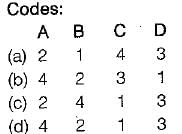Test: Heat Transfer By Forced Convection - 1 - Chemical Engineering MCQ
10 Questions MCQ Test - Test: Heat Transfer By Forced Convection - 1
Match the following List-l (Dimensionless number) with List-ll (Physical interpretation).
List-l
A. Drag coefficient
B. Eckert number
C. Colburn j factor
D. Fourier number
List-ll
1. Dimensionless heat transfer coefficient
2. Ratio of shear stress to free stream kinetic energy
3. Dimensionless time
4. Kinetic energy of flow relative to boundary- layer enthalpy difference

List-l
A. Drag coefficient
B. Eckert number
C. Colburn j factor
D. Fourier number
1. Dimensionless heat transfer coefficient
2. Ratio of shear stress to free stream kinetic energy
3. Dimensionless time
4. Kinetic energy of flow relative to boundary- layer enthalpy difference

Which of the following dimensionless number/parameter is different from others?
Match List-l with List-ll
List-l
A. Reynolds number
B. Prandtl number
C. Nusselt number
D. Mach number
List-lI
1. Film coefficient, pipe diameter, thermal conductivity
2. Flow velocity, acoustic velocity
3. Heat capacity, dynamic viscosity, thermal conductivity
4. Flow velocity, pipe diameter, kinematic viscosity

List-l
A. Reynolds number
B. Prandtl number
C. Nusselt number
D. Mach number
1. Film coefficient, pipe diameter, thermal conductivity
2. Flow velocity, acoustic velocity
3. Heat capacity, dynamic viscosity, thermal conductivity
4. Flow velocity, pipe diameter, kinematic viscosity

Stanton number may be interpreted as the ratio of
The Nusselt number is related to Reynolds number in laminar and turbulent flows respectively as
For turbulent flow over a flat plate, the average value of Nusselt number is prescribed by the relation

Which of the followings is then a false statement? The average heat transfer coefficient increase as
The flow and heat transfer in coiled tubes are governed by
Which one of the following is flow properly
For a fluid having Prandtl number equal to unity how are the hydrodynamic boundary layer thickness δ and the thermal boundary layer thickness δt related

















